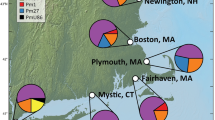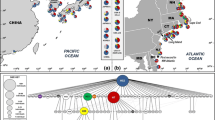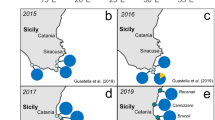Abstract
The introduction and spread of non-indigenous species (NIS) in marine ecosystems accelerated during the twentieth century owing to human activities, notably international shipping. Genetic analysis has proven useful in understanding the invasion history and dynamics of colonizing NIS and identifying their source population(s). Here we investigated sequence variation in the nuclear ribosomal Internal Transcribed Spacer region of the ctenophore Mnemiopsis leidyi, a species considered one of the most invasive globally. We surveyed four populations from the native distribution range along the Atlantic coasts of the United States and South America, as well as six populations in the introduced range from the Black, Azov, Caspian and Baltic seas. Allelic and nucleotide diversity of introduced populations were comparable to those of native populations from which they were likely drawn. Introduced populations typically exhibited lower genetic differentiation (F ST = −0.014–0.421) than native populations (F ST = 0.324–0.688). Population genetic analyses supported the invasion of Eurasia from at least two different pathways, the first from the Gulf of Mexico (e.g., Tampa Bay) to the Black Sea and thence to the Caspian Sea, the second from the northern part of the native distribution range (e.g., Narragansett Bay) to the Baltic Sea. The relatively high genetic diversity observed in introduced populations is consistent with large inocula and/or multiple invasions, both of which are possible given ballast water transport and the extensive native distribution of the ctenophore in the Atlantic Ocean.



Similar content being viewed by others
References
Biosecurity New Zealand (2009) Ministry of Agriculture and Forestry. http://www.biosecurity.govt.nz/regs/ships. Accessed 1 Oct 2009
Boero F, Putti M, Trainito E, Prontera E, Piraino S, Shiganova TA (2009) First records of Mnemiopsis leidyi (Ctenophora) from the Ligurian, Thyrrhenian and Ionian Seas (Western Mediterranean) and first record of Phyllorhiza punctata (Cnidaria) from the Western Mediterranean. Aquat Invas 4:675–680
Boersma M, Malzahn AM, Greve W, Javidpour J (2007) The first occurrence of the Mnemiopsis leidyi in the North Sea. Helgol Mar Res 61:153–155
Brown JE, Stepien CA (2009) Invasion genetics of the Eurasian round goby in North America: tracing sources and spread patterns. Mol Ecol 18:64–79
Carlton JT (1985) Transoceanic and interoceanic dispersal of coastal marine organisms: the biology of ballast water. Oceanogr Mar Bio Ann Rev 23:313–371
Chandler EA, McDowell JR, Graves JE (2008) Genetically monomorphic invasive populations of the rapa whelk (Rapana venosa). Mol Ecol 17:4079–4091
Clement M, Posada D, Crandall KA (2000) TCS: a computer program to estimate gene genealogies. Mol Ecol 9:1657–1659
Coleman AW, Vacquier VD (2004) Exploring the phylogenetic utility of ITS sequences for animals: a test case for abalone (Haliotis). J Mol Evol 54:246–257
Cristescu MEA, Hebert PDN, Witt JDS, MacIsaac HJ, Grigorvich IA (2001) An invasion history for Cercopagis pengoi based on mitochondrial gene sequences. Limnol Oceanogr 46:224–229
Darling JA, Bagley MJ, Roman J, Tepolt CK, Geller JB (2008) Genetic patterns across multiple introductions of the globally invasive crab genus Carcinus. Mol Ecol 17:4992–5007
Dlugosch KM, Parker IM (2008) Founding events in species invasions: genetic variation, adaptive evolution, and the role of multiple introductions. Mol Ecol 17:431–449
Duran S, Gribet G, Turon X (2004) Phylogeographical history of the sponge Crambe crambe (Porifera, Poecilosclerida): range expansion and recent invasion of the Macaronesian islands from the Mediterranean Sea. Mol Ecol 13:109–122
Elphinstone MS, Hinten GN, Anderson MJ, Nock CJ (2003) An inexpensive and high-throughput procedure to extract and purify total genomic DNA for population studies. Mol Ecol Notes 3:317–320
Evans B, Bartlett J, Sweijd N, Cook P, Elliott NG (2004) Loss of genetic variation at microsatellite loci in hatchery produced abalone in Australia (Haliotis rubra) and South Africa (Haliotis midae). Aquaculture 233:109–127
Excoffier L, Guillaume L, Schneider S (2005) Arlequin (version 3.0): an integrated software package for population genetics data analysis. Evol Bioinform 1:47–50
Faasse MA, Bayha KM (2006) The ctenophore Mnemiopsis leidyi A. Agassiz 1865 in coastal waters of the Netherlands: an unrecognized invasion? Aquat Invas 1:270–277
Frankham R (2005) Genetics and extinction. Biol Conserv 126:131–140
Frankham R, Ballou JD, Briscoe DA (2002) Introduction to conservation genetics. Cambridge University press, Cambridge
Fu YX, Li WH (1993) Statistical tests of neutrality of mutations. Genetics 133:693–709
Fuentes VL, Atienza D, Gili JM, Purcell JE (2009) First record of Mnemiopsis leidyi A. Agassiz 1865 off the NW Mediterranean coast of Spain. Aquat Invas 4:671–674
Galil B, Kress N, Shiganova TA (2009) First record of Mnemiopsis leidyi A. Agassiz, 1865 (Ctenophora; Lobata; Mnemiidae) off the Mediterranean coast of Israel. Aquat Invas 4:356–362
GESAMP (Group of Experts on Scientific Aspects of Marine Environmental Protection) (1997) Opportunistic settlers and the problem of the ctenophore Mnemiopsis leidyi invasion in the Black Sea. Rep Stud No. 58
Gillis NK, Walters LJ, Fernandes FC, Hoffman EA (2009) Higher genetic diversity in introduced than in native populations of the mussel Mytella charruana: evidence of population admixture at introduction sites. Divers Distrib 15:784–795
Harbison GR, Miller RL (1986) Not all ctenophores are hermaphrodites. Studies on the systematics, distribution, sexuality and development of the two species of Ocyrosis. Mar Biol 90:413–424
Hauser L, Adcock GJ, Smith PJ, Bernal Ramirez JH, Carvalho GR (2002) Loss of microsatellite diversity and low effective population size in an overexploited population of New Zealand snapper Pagrus auratus. Proc Natl Acad Sci USA 99:11742–11747
Huang D, Meier R, Todd PA, Chou LM (2008) Slow mitochondrial COI sequence evolution at the base of the metazoan tree and its implications for DNA barcoding. J Mol Evol 66:167–174
IMO (International Maritime Organization) (1993) Guidelines for preventing the introduction of unwanted aquatic organisms and pathogens from ships’ ballast water and sediment discharges. Resolution A.774 (18). http://www.directemar.cl/dai/dai-esp/r-omi/asamblea/las%20q%20faltan/A.774.pdf
Ivanov VP, Kamakin AM, Ushivtsev VB, Shiganova TA, Zhukova OP, Aladin N, Wilson SI, Harbison GR, Dumont HJ (2000) Invasion of the Caspian Sea by the comb jellyfish Mnemiopsis leidyi (Ctenophora). Biol Invas 2:255–258
Javidpour J, Sommer U, Shiganova TA (2006) First record of Mnemiopsis leidyi A. Agassiz 1865 in the Baltic Sea. Aquat Invas 1:299–302
Javidpour J, Molinero JC, Peschutter J, Sommer U (2009) Seasonal changes and population dynamics of the ctenophore Mnemiopsis leidyi after its first year of invasion in the Kiel Fjord, Western Baltic Sea. Biol Invas 11:873–882
Kelly DW, Muirhead JR, Heath DD, MacIsaac HJ (2006) Contrasting patterns in genetic diversity following multiple invasions of fresh and brackish waters. Mol Ecol 15:3641–3653
Kideys AE, Niermann U (1994) Occurrence of Mnemiopsis along the Turkish coast. ICES J Mar Sci 51:423–427
Kochzius M, Nolte M, Weber H, Silkenbeumer N, Hjorleifsdottir S, Hreggvidsson GO, Marteinsson V, Kappel K, Planes S, Tinti F, Magoulas A, Garcia Vasquez E, Turan C, Hervet C, Campo Falgueras D, Antoniou A, Landi M, Blohm D (2008) DNA microarrays for identifying fishes. Mar Biotechnol 10:207–217
Leuven RSEW, van der Velde G, Baijens I, Snijders J, van der Zwart C, Lenders HJR, Bij de Vaate A (2009) The river Rhine: a global highway for dispersal of aquatic invasive species. Biol Invas 11:1989–2008
Librado P, Rozas J (2009) DnaSP v5: a software for comprehensive analysis of DNA polymorphism data. Bioinformatics 25:14–1451
Lockwood JL, Cassey P, Blackburn TM (2009) The more you introduce the more you get: the role of colonization pressure and propagule pressure in invasion ecology. Divers Distrib 15:904–910
Lowe S, Browne M, Boudjelas S, De Poorter M (2000) 100 of the world’s worst invasive alien species. Aliens 12:S1–S12
Molnar JL, Gamboa RL, Revenga C, Spalding MD (2008) Assessing the global threat of invasive species to marine biodiversity. Frontiers Ecol Environ 6:485–492
Muirhead JR, Gray DK, Kelly DW, Ellis SM, Heath DD, MacIsaac HJ (2008) Identifying the source of species invasions: sampling intensity versus genetic diversity. Mol Ecol 17:431–449
Nei M (1972) Genetic distance between populations. Am Nat 106:283–292
Nei M (1987) Molecular evolutionary genetics. Columbia University Press, New York
Oliveira OMP (2007) The presence of the ctenophore Mnemiopsis leidyi in the Oslofjorden and considerations on the initial invasion pathways to the North and Baltic Seas. Aquat Invas 2:185–189
Podar M, Haddock SHD, Sogin ML, Harbison GR (2001) A molecular phylogenetic framework for the phylum ctenophora using 18s rRNA genes. Mol Phylogenet Evol 21:218–230
Purcell JE, Uye S, Lo WT (2007) Anthropogenic causes of jellyfish blooms and their direct consequences for humans: a review. Mar Ecol Prog Ser 350:153–174
Raskoff KA, Sommer FA, Hamner WM, Cross KM (2003) Collection and culture techniques for gelatinous zooplankton. Biol Bull 204:68–80
Ricciardi A (2006) Patterns of invasion in the Laurentian Great Lakes in relation to changes in vector activity. Divers Distrib 12:425–433
Richardson AJ, Bakun A, Hays GC, Gibbons MJ (2009) The jellyfish joyride: causes, consequences and management responses to a more gelatinous future. Trends Ecol Evol 24:312–322
Rius M, Pascual M, Turon X (2008) Phylogeography of the widespread marine invader Microcomus squamiger (Ascidiacea) reveals high genetic diversity of introduced populations and non-independent colonizations. Divers Distrib 14:818–828
Rollins LA, Woolnough AP, Wilton AN, Sinclaire R, Sherwin WB (2009) Invasive species can’t cover their tracks: using microsatellites to assist management of starling (Sturnus vulgaris) populations in Western Australia. Mol Ecol 18:1560–1573
Roman J (2006) Diluting the founder effect: cryptic invasions expand a marine invader’s range. Proc R Soc B 273:2453–2459
Roman J, Darling JA (2007) Paradox lost: genetic diversity and the success of aquatic invasions. Trends Ecol Evol 22:454–464
Ruiz GM, Carlton JT (2003) Invasion vectors: a conceptual framework for management. In: Ruiz GM, Carlton JT (eds) Invasive species, vectors and management strategies. Island Press, Washington, pp 459–498
Shiganova TA (1993) Ctenophore Mnemiopsis leidyi and ichthyoplankton in the Sea of Marmara in October of 1992. Oceanology 33:900–903
Shiganova TA, Dumont H (2011) Non-native species in the southern seas of Eurasia: distribution, impacts, pathways and vectors. Springer Monograph Series, The Netherlands (in press)
Shiganova TA, Malej A (2009) Native and non-native ctenophores in the Gulf of Trieste, Northern Adriatic Sea. J Plank Res 31:61–71
Shiganova TA, Mirzoyan ZA, Studenikina EA, Volovik SP, Siokou-Frangou I, Zervoudaki S, Christou ED, Skirta AY, Dumont HJ (2001) Population development of the invader ctenophore Mnemiopsis leidyi in the Black Sea and other seas of the Mediterranean basin. Mar Biol 139:431–445
Shiganova TA, Dumont HJ D, Sokolsky AF, Kamakin AM, Tinentova D, Kurasheva EK (2004) Population dynamics of Mnemiopsis leidyi in the Caspian Sea, and effects on the Caspian ecosystem. In: Dumont H, Shiganova TA, Niermann U (eds) The Ctenophore Mnemiopsis leidyi in the Black, Caspian and Mediterranean Seas and other aquatic invasions. Kluwer, Dordrecht, pp 71–111
Shiganova TA, Musaeva EI, Pautova LA, Bulgakova YuV (2005) The problem of invaders in the Caspian Sea in the context of the findings of new zoo- and phytoplankton species from the Black Sea. Biol Bull 1:78–87
Shiganova TA, Bulgakova YV, Siokou-Frangou I, Christou ED, Maley A, Javanshir J (2007) Phenology and population dynamics of the invasive ctenophore Mnemiopsis leidyi in the recipient areas of the Eurasian Seas—changes linked with environmental variability and climate forcing. In: 15th International conference on aquatic invasive species, 23–27 Sep 2007, Nijmegen, p 152
Spielman D, Brook BW, Frankham R (2004) Most species are not driven to extinction before genetic factors impact them. Proc Natl Acad Sci USA 10142:15261–15264
Streftaris N, Zenetos A, Papathanassiou E (2005) Globalisation in marine ecosystems: the story of non-indigenous marine species across European seas. Oceanogr Mar Biol 43:419–453
Tajima F (1989) Statistical-method for testing the neutral mutation hypothesis by DNA polymorphism. Genetics 123:585–595
Tamura K, Dudley J, Nei M, Kumar S (2007) MEGA4: molecular evolutionary genetics analysis (MEGA) software version 4.0. Mol Biol Evol 24:1596–1599
Taylor DR, Keller SR (2007) Historical range expansion determines the phylogenetic diversity introduced during contemporary species invasion. Evolution 61:334–345
Templeton AR, Crandall KA, Sing CF (1992) A cladistic-analysis of phenotypic associations with haplotypes inferred from restriction endonuclease mapping and DNA sequence data.3. Cladogram estimation. Genetics 132:619–633
Thomas VG, Vasarhelyi C, Niimi AJ (2009) Legislation and capacity for rapid-response management of nonindigenous species of fish in contiguous waters of Canada and the USA. Aquat Conserv Mar Freshw Ecosyst 19:354–364
Vasarhelyi C, Thomas VG (2003) Analysis of Canadian and American legislation for controlling exotic species in the Great Lakes. Aquat Conserv Mar Freshw Ecosyst 13:417–427
White TJ, Burns T, Lee S, Taylor J (1990) Amplification and direct sequencing of fungal ribosomal RNA genes for phylogenetics. In: Innis MA, Gelfand DH, Shinsky JJ, White TJ (eds) PCR protocols: a guide to methods and applications. Academic Press, San Diego, pp 315–322
Wilson JRU, Dormontt EE, Prentis PJ, Lowe AJ, Richardson DM (2009) Something in the way you move: dispersal pathways affect invasion success. Trends Ecol Evol 24:136–144
Wonham MJ, Carlton JT (2005) Trends in marine biological invasions at local and regional scales: the Northeast Pacific Ocean as a model system. Biol Invas 7:369–392
Yeh FC, Yang R, Boyle TJ, Ye Z, Xiyan JM (2000) POPGENE 32, Microsoft Windows-based freeware for population genetic analysis. Molecular Biology and Biotechnology Centre, University of Alberta, Edmonton
Yu ET, Juinio-Menez MA, Monje VD (2000) Sequence variation in the ribosomal DNA internal transcribed spacer of Tridacna crocea. Mar Biotechnol 2:511–516
Acknowledgments
We are grateful to J. Cope, A. Durbin, E. Durbin, J. Javidpour, H. Mianzan, and C. Stepien for providing samples. E. Briski and C. Lejeusne provided valuable laboratory assistance. This study was supported financially by NSERC Discovery Grants to MEC and HJM, a University of Windsor Travel Award to TAS, an Early Researcher Award to MEC, and by a DFO Invasive Species Research Chair to HJM.
Author information
Authors and Affiliations
Corresponding author
Electronic supplementary material
Below is the link to the electronic supplementary material.
Rights and permissions
About this article
Cite this article
Ghabooli, S., Shiganova, T.A., Zhan, A. et al. Multiple introductions and invasion pathways for the invasive ctenophore Mnemiopsis leidyi in Eurasia. Biol Invasions 13, 679–690 (2011). https://doi.org/10.1007/s10530-010-9859-8
Received:
Accepted:
Published:
Issue Date:
DOI: https://doi.org/10.1007/s10530-010-9859-8




